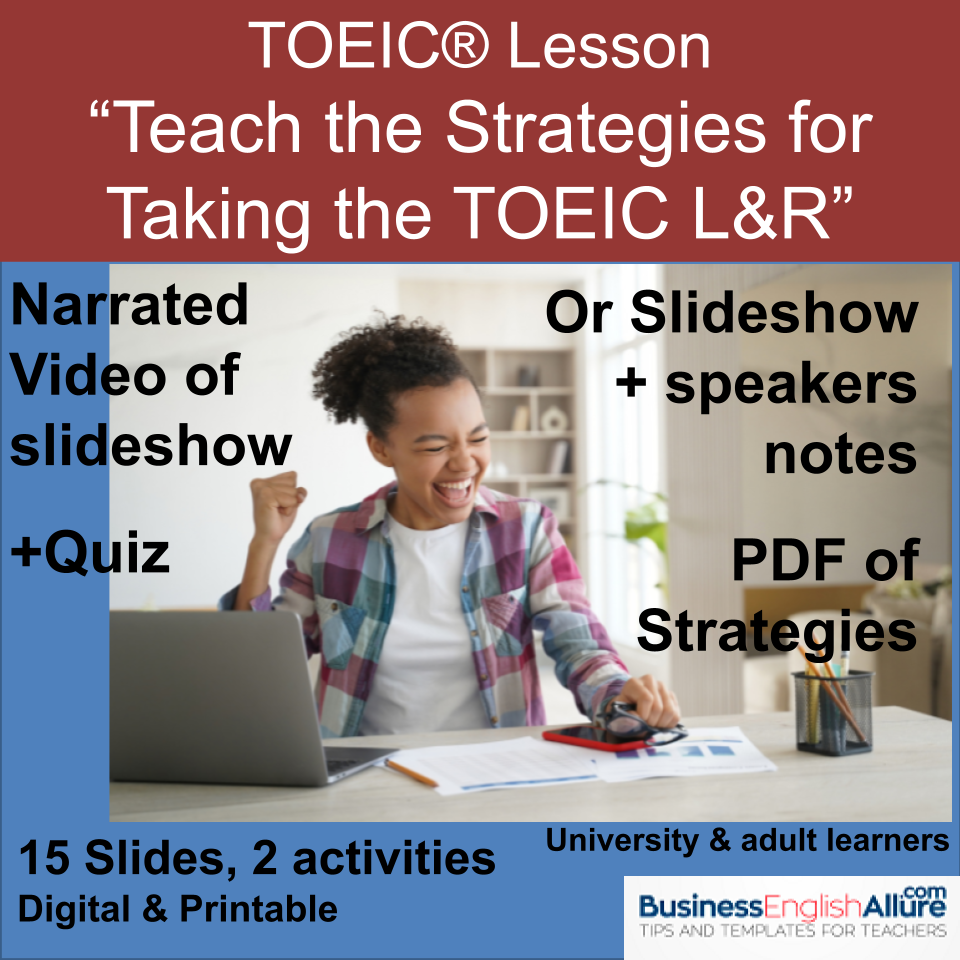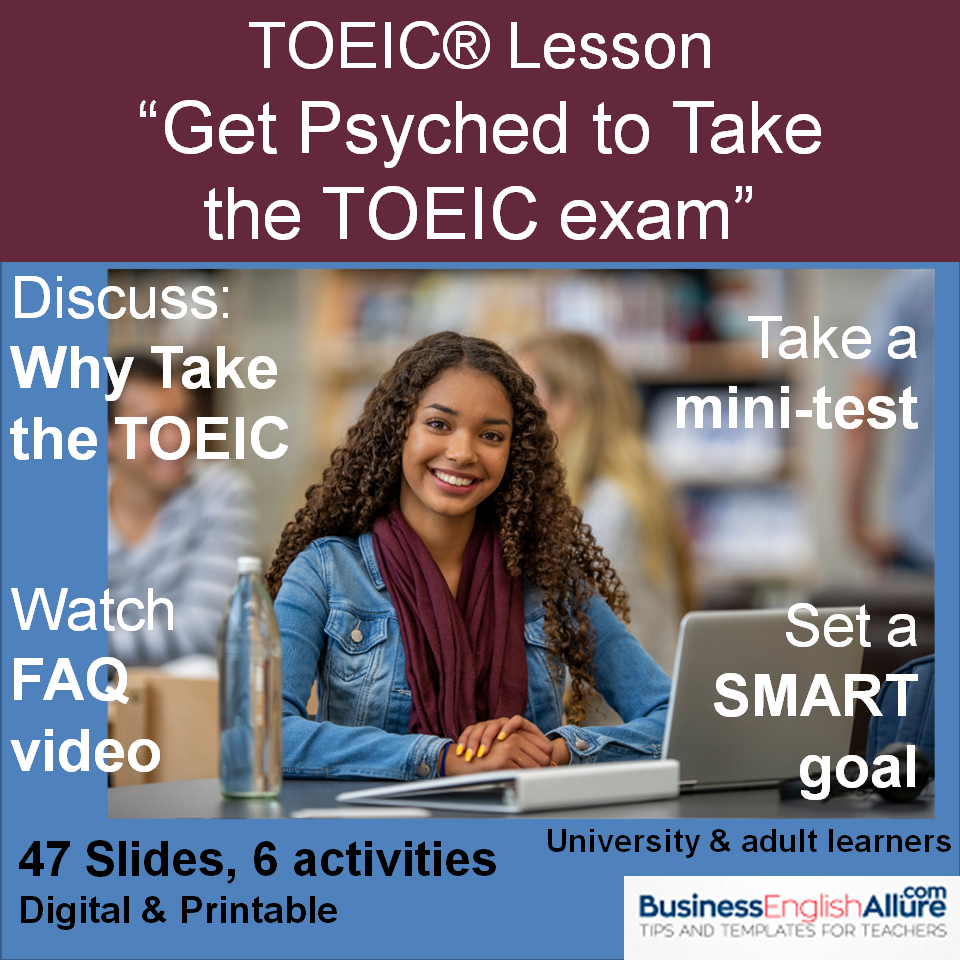Taking the TOEIC L&R Skills and Strategies

When taking the TOEIC L&R use these skills and strategies to boost your TOEIC score. All seven parts are covered and you can practice with a mini-test part by part. Knowing what to expect on the official test day is reassuring, soothes fear of the unknown, and reduces stress. The perfect way to prepare for a test, wouldn’t you say?
Watch this video covering the strategies or Read on for more all the details
IDEA: Use a TOEIC mini-test to teach or practice skills and strategies
In this lesson plan, use a mini-test rather than a full two-hour practice test to teach the skills and strategies. Go over each part in order studying the strategies provided here. Then complete that part of the mini-test, trying to apply the associated strategies, and then correct their answers.
Take the time to think about and discuss why certain answers are wrong, and decide if the strategies helped before moving on to the next part. Circle or highlight any new vocabulary in the practice test booklet including the tapescript for Listening Parts 1-4. Lots of vocabulary there.
I suggest using this free sample test (mini-test) provided by ETS, the makers of the TOEIC. Download the PDF of the test booklet here with answers and tapescripts. Find and Download the audio tracks here. Here is where you will Download the blank answer sheet here. The answer sheet will give students their % score. Download this conversion table to obtain a TOEIC score in points.
TOEIC trainers: You should take the test too
This blog post is about advice a teacher (you) could give to students. So I chose to use the personal pronoun “you” rather than “students” or “test-takers” because I think “you” should take a practice test yourself, to grasp just how difficult it is. Especially the listening.
In my training as a TOEIC teacher, we were given a full two-hour practice test. My score was shockingly low. As a native speaker with years of experience teaching ESL, I expected a perfect score. Most of my mistakes were found in Listening Part 4 where we listened to a short talk loaded with unnecessary details. I gazed out the window to concentrate on listening, instead of reading the question(s) first to listen for and remember only the details that mattered. Take a full practice test, and see for yourself where the pitfalls lie.

Look at me!
Using these strategies I got a perfect score of 990 points!
I took the official test under “real” conditions during my training at ETS to be a TOEIC monitor. I concentrated maximum and used all of the following strategies.
Download this article as a PDF to use as a handout in class.
Overall Listening Section Strategies when taking the TOEIC:
The Listening Section is fast-paced. The most common errors are: losing your place on the answer sheet and not keeping up. Don’t spend more than 10 seconds answering each question.
The “same voice” will announce the “same directions” on test day. It’s critical to understand the directions correctly so read them along with the announcer.
There are four different accents presented in the TOEIC listening: American, British, Canadian, and Australian. It should be reassuring to know that you will hear the same voices (the same people) throughout the Listening Section speaking at a moderate pace.
Don’t write in the test booklet. You could risk being disqualified for any hand-written notes in the numbered test booklet associated with your name and answer sheet.
Don’t lose your place on the answer sheet. Keep your pencil on the answer sheet, poised on the correct number ready to mark your answer. Rest your pencil over the letter of the answer being read, stop there if you like it, but continue listening to the other choices. Color in your answer choice, quickly but neatly.
On this style of a multiple-choice test, if you are in doubt, then guess. Wrong answers are not penalized as is the case in so many countries. Don’t leave any questions blank. I learned in a training course for TOEIC monitors, that C is the most common answer choice. During the listening section, don’t get left behind. If you’re stuck, choose C and move on.
Part 1 Photos-Listening Strategies for Taking the TOEIC

Watch out for the example photo with questions. Don’t answer it. It is not Question N°1.
Students will only “hear” the four answer choices. They will not be printed in the test book. Look at the photo, and listen to the four statements. Choose the “best” statement and mark it immediately on your answer sheet to be ready to look over the next photo before the announcer begins speaking. You’ve only got 10 seconds to mark your answer.
Before the announcer begins the next series of four statements, take a moment to scan the photo to identify vocabulary and verbs that might be used in the questions. Think: who, what, when, where.
Photos could portray people doing actions: verbs are often in the present continuous +ing = “He is repairing the machine”, OR the passive voice in the present = “The machine is being repaired”, OR Passive Voice in the past = “The machine has been repaired.”
Statements about the image could focus on the position of people or things using prepositions of place (beside, in front of, next to) or prepositions of movement (towards, through, across). Be careful because the action may be correct but the location of the person or object is incorrect.
Answer choices could include the names of locations such as a harbor, or a garden.
Lastly, be careful about making assumptions about the photo. The correct statement will be visible in the image. The decision for the “best” answer choice should be based on fact, not assumption.
At the end of Part 1, pause the recording to correct the answers. Ask students to take note of any new vocabulary found in all the answer choices. Ask them to think about “why” some answer choices are incorrect.
Part 2 Question/Response Listening Strategies for Passing the TOEIC

Listening Part 2 is difficult for students on the day of the test because they have to keep their heads down focusing on the answer sheet during 25 questions. It’s so easy to lose your place and you get a crick in your neck from resting in the same tense position. In the mini-test, we only have four questions.
We only “hear” the question and the four answer choices. They are not printed in the test book.
Just focus on the answer sheet as you listen to the question and the three answer choices. Keep your pencil on the answer sheet and verify the number of the question. It is very easy to lose your place.
Keep the question in mind as you listen to the three responses and choose the answer that makes sense. Questions starting with “who, what, when, where, why” usually need logical answers.
Sometimes the best answer will not be a direct response to the question. Q: “How many applicants applied for the position?” A: “I’m disappointed because we haven’t received as many CVs as we expected.” This is English as it is commonly used. Answers are not always grammatically related to the question. Sometimes there will be yes/no questions but no direct yes/no answer choice.
Watch out for questions with “question tags”. “You reserved the conference room, didn’t you?” A: “Yes, I did.” or “No, I didn’t”.
Part 3 Dialogues Listening Strategies

In Part 3 you will hear short conversations (dialogues) with three comprehension questions per conversation. It’s very important to read the three questions before the recording begins. The questions will give you context and if you have time to read the answer choices too, you will see vocabulary that you might hear during the conversation.
Stay focused on the questions and answer choices in your test book while listening. Keep your pencil in place on the answer sheet and mark the answer as soon as you hear it.
If you’re certain that you won’t have enough time to read the questions before the conversation begins, keep these questions in mind and try to answer them as you listen to the conversation. 1. Who are the speakers? 2. What is their profession? 3. What is their relationship? 4. Where are they? 5. What are they discussing? 6. Why are they discussing this?
Part 4 Short Talks Listening Strategies

In Part 4, you will hear short monologues (weather forecast, an announcement). The “type of talk” will be given in the introduction. Read all three questions before the monologue begins so that you will know what details to listen for and then focus on the questions and answer choices in your Test Book while listening.
Keep your pencil in place on the answer sheet and mark the answer as soon as you hear it. When the recording ends, quickly guess the remaining answers so that you can move on to reading the next set of questions. Don’t get left behind.
Some students won’t have time to read the questions before the listening starts. You could practice with these students to listen for answers to these questions. Write the following questions on the board. Ask students to answer as many of these questions as they can while listening to each short talk: 1. Who is the speaker? 2. What is his/her profession? 3. Where is the speaker? 4. What is the purpose of the talk? 5. Who is the audience?
Overall Reading Section Strategies for taking the TOEIC exam:
The biggest obstacle to the Reading Section is finishing on time. On test day, students will have only 75 minutes to complete 100 reading questions. When I took the TOEIC test during my training as a monitor for a testing center, I had to focus all my attention on finishing. I finished 10 minutes early and felt pretty good as I swaggered out of the testing center. However, I had been training students in TOEIC preparation for years, dedicated my full attention, and used all the strategies I had been teaching students.
Do parts 5 and 6 quickly: 30 seconds per question maximum. For the full two-hour test, try for 8 minutes for each Part or 16 minutes combined. Save all your precious minutes for Part 7, the reading comprehension.
Some teachers suggest students go directly to Part 7 and begin there, rather than completing the test in order. This is based on the logic that in a reading comprehension exercise, the answer can be found in the text by searching. The answer is bound to be there as compared to the fill-in-the-gap exercises in Parts 5 and 6 where no amount of looking or pondering over the four answer choices will help if you don’t know the grammar rule or you don’t know the vocabulary. Your choice.
.
Part 5 Sentence Completion Reading Strategies

Get in the habit of doing the gap-filling exercises in Part 5 quickly (less than 30 seconds per question).
Part 5 is all about grammar knowledge and vocabulary knowledge. Look at the four answer choices first and decide how are they similar (Ex: all four choices are nouns, or prepositions, etc.). How are they different? (Ex: the same part of speech but different meanings, or word families). Then read the question to look for clues to choose the answer choice.
Expect to see gaps for choosing the correct: verb tense, pronoun, adjective form (-ed, +ing, etc.), transition word (however, therefore, etc.), conjunction (and, but, because of, etc.) or similar vocabulary.
Once you’ve made your choice, reread the question with the answer plugged into the gap. Let your inner voice tell you if it “sounds” correct. But do it quickly. Trust your instincts.
Assure your students that this part of the test is only a small percentage of the test even though they will see grammar exercises as the basis of most TOEIC preparation courses. Admonish them to change their mindset from being obsessed with grammar to a mindset focused on building expressions. The TOEIC test is 75% vocabulary and workplace expressions and only 25% grammar.
TOEIC experts agree that a large vocabulary is essential to success. Read my blog post /experts-agree-teaching-toeic-vocabulary-is-vital/ if you need convincing to change your mindset too.
Part 6 Text Completion Reading Strategies

The strategies for Part 6 are similar to Part 5 in that students will be tested on grammar or vocabulary but the sentence they are asked to complete is included within a text. This complicates choosing an answer choice because the student could be asked to consider the grammar aspect of the four answer choices or the context and the tone of the entire text.
Nonetheless, go directly to the first question in the text, analyze the four answer choices for similarities or differences, then read the sentence. Don’t be tempted to read the full text. Remember Part 6 is not, for the most part, a comprehension exercise. It’s grammar and vocabulary.
There will certainly be a question where you will not have enough information in the sentence to answer the question. In this case “skim” the surrounding sentences for clues. But be quick. That’s what skimming means.
Once again, answer questions quickly and try not to get stuck on any one question. Resist spending precious time on contemplation. It is Part 7 where you will need all the time you can get to analyze nuance and intentions.
Part 7 Reading Comprehension Strategies

Part 7 is reading comprehension. It starts easily with only one document (one passage, one text) for two comprehension questions. Then the document becomes longer and longer with two corresponding questions, then three questions, then four questions.
Luckily, the order of the questions often follows the order of the information presented in the text. Single documents could be an email, a fax, an article from the press, an advertisement.a text message thread (chain), an online chat discussion, a notice on a bulletin board, or maybe an opinion survey
Then the complexity of Part 7 slowly increases. There will be two documents for five questions, then the complexity climbs to three documents with five comprehension questions. There will be a main document (ex: the schedule of activities at a resort hotel), then side documents (an email announcing changes to the schedule) and then an online comment from a guest reviewing the activities.
Quickly identify the kinds of documents presented: It could be an email, a price list, a graph…
Read the questions and imagine which document most likely holds the answer.
Avoid diving headfirst into the passage(s). It can be scary for lower-level learners faced with a huge block or blocks of text and it’s inefficient for all levels. Instead, read the questions first and then refer to the passage to find what you’re looking for.
For Part 7 Practice Scanning and Skimming texts
Utilize efficient reading techniques like skimming and scanning to locate the information you need. Find the purpose of an email or fax in the subject line. In a letter of complaint, the first paragraph holds lots of pertinent information: order date, and number. The second paragraph will focus on the complaint itself. In an article, read the headline for to identify the purpose of the text then read the subheadings to identify the section to be skimmed.
While each question carries the same point value, some require less time to answer than others. In Part 7, an extra minute on a challenging question can make a significant difference. Questions asking for specific details or vocabulary can be answered quickly. Do those first. Scan the passage to locate the relevant section and then answer the question.
Questions asking about the overall meaning or the writer’s intent demand a deeper understanding of the passage and may take longer.
If a question stumps you, leave it blank. At the end of the exam, the monitor (proctor) will announce that five minutes are remaining. This is your opportunity to go to your answer sheet and quickly mark Answer C to any unanswered questions in the Reading Section 101-200.
Leave a comment and signup for more useful stuff
I hope you’ll see a decrease in stress and an increase in confidence for you and your students. Leave a comment if you liked this post.
Signup for the newsletter if you want to receive more posts.
Need another TOEIC lesson plan?
/toeic-lesson-plan-discussing-goals-and-success/
/what-is-the-toeic-test-all-your-questions-answered/
/toeic-lesson-plan-leverage-english-skills-to-achieve-goals/
I’ve got a store on TeachersPayTeachers.com

This blog post made into a no-preparation lesson
You’ll get everything in the above blog post PLUS extras:
- + The slideshow you narrate yourself with instructions,
- The narrated video of the slide show,
- a PDF of the blog post, a link to a mini-test so students can practice the strategies,
- + a 10-question quiz as a slide show or printable.
- + You can use this lesson online or in person.
Buy this ready-made TOEIC lesson plan on “TOEIC Lesson Plan: Teach the Strategies for Taking the TOEIC L&R .” Just $3 for a 3-hour lesson. Pay with PayPal. Digital & printable versions.

Introduction to the TOEIC ready-made lesson
You can also find abbreviated TOEIC strategies included in this more comprehensive introduction to the TOEIC L&R lesson.
You’ll get: ● 47 slides with speaker notes ● Guessing activity “4 Reasons why 6 million people take the TOEIC” ● Video with activity: TOEIC FAQs ● Pick a target TOEIC score to aim for based on average scores for your country or region.● Take a 45m mini-test answers provided plus test-taking strategies for Parts 1-7● Calculate the number of study hours needed to reach the target score
Buy this ready-made TOEIC lesson plan on “TOEIC Lesson Plan: How to Set a Target Score and SMART Goal.” Just $5 for a 6-hour lesson. Pay with PayPal. Digital & printable versions.











